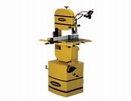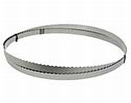Bandsaw Blade Removal and Replacement
 Despite the relative simplicity of changing the blades on our miter and circ saws, not all upkeep procedures for our woodworking equipment are created equally. As it turns out, removing and replacing the blade on a bandsaw requires a significant bit more effort and patience from the operator. Don’t let this fact dissuade you, though, with the right bit of know-how, replacing the blade on your bandsaw can be as easy as pie – and just as satisfying.
Despite the relative simplicity of changing the blades on our miter and circ saws, not all upkeep procedures for our woodworking equipment are created equally. As it turns out, removing and replacing the blade on a bandsaw requires a significant bit more effort and patience from the operator. Don’t let this fact dissuade you, though, with the right bit of know-how, replacing the blade on your bandsaw can be as easy as pie – and just as satisfying.
Safety Measures:
The first step, of course, is ensuring you are safe and prepared for the impending procedure. This means, you must disengage the bandsaw and unplug it from its power source. This also means that you should be wearing goggles and preferably long-pants. Bandsaw blades have a tendency to fly off the handle, so to speak.
Removing Your Former Blade:
 Removing the old bandsaw blade is the next step. First, you will usually need to remove the blade insert and the table pin from the saw table. Next, to release the blade, loosen each set of the bandsaw’s blade guides. Making enough space to allow for the simplest reinstallation of your new blade, loosen the upper ball bearing guide and the upper block guides. Block guides must be loosened at all four directions – left-right and forward-back. Following this, additionally loosen the lower blade guides beneath the saw table. Each blade guide has an adjustment knob to make this step a bit simpler.
Removing the old bandsaw blade is the next step. First, you will usually need to remove the blade insert and the table pin from the saw table. Next, to release the blade, loosen each set of the bandsaw’s blade guides. Making enough space to allow for the simplest reinstallation of your new blade, loosen the upper ball bearing guide and the upper block guides. Block guides must be loosened at all four directions – left-right and forward-back. Following this, additionally loosen the lower blade guides beneath the saw table. Each blade guide has an adjustment knob to make this step a bit simpler.
Next, using the tension wheel (knob), release the tension on the blade. Once tension is adequately released, you should be able to slide the blade safely from the blade-wheel through the slot in the saw table. Carefully recoil the blade and tie it off to prevent the thing from becoming an explosive blade disaster.
Making Friends With Your New Blade:
 Opening your new bandsaw blade can also become an explosive blade disaster. This is why there is a time-tested and woodworker-specialized method for safely uncoiling your bandsaw blades. Said method is as follows: throw the blade on the ground. Well, more specifically, if your blade is packaged or tied, carefully unpackage or untie it while maintaining its coil. With a firm grip on the blade, throw it away from your body and into an open space. The blade will violently uncoil and fall to the floor from where you can peacefully collect it. You may also wear gloves during this process – they will eliminate the possibility of cut hands and fingers.
Opening your new bandsaw blade can also become an explosive blade disaster. This is why there is a time-tested and woodworker-specialized method for safely uncoiling your bandsaw blades. Said method is as follows: throw the blade on the ground. Well, more specifically, if your blade is packaged or tied, carefully unpackage or untie it while maintaining its coil. With a firm grip on the blade, throw it away from your body and into an open space. The blade will violently uncoil and fall to the floor from where you can peacefully collect it. You may also wear gloves during this process – they will eliminate the possibility of cut hands and fingers.
Installing Your New Blade:
Thread the new blade back through the slots on the saw table and situate the blade around, and running through the center of, the upper and lower blade-wheels. Again using the tension wheel (knob), apply tension to the new blade. You may need to hold the blade in place until the tension itself becomes enough to maintain the blade’s position. Just exactly how much tension you apply to the blade is dependent upon the type, more specifically the width, of blade you’ve installed. There should be a tension-indicator on the back of your bandsaw to help you find the proper tension for your blade.
Tracking:
Once you’ve applied proper tension to the blade, it needs to be tracked, or, centered. Using the tracking knob on the side of the band saw you can perfectly center the blade on the blade-wheels. Turn this knob while using your other hand to spin the blade wheel. This will allow you to see all of the blade and to track it accordingly.
Adjusting:
Next, finalize the adjustments to your upper ball bearing guide which should sit just exactly behind, though not touching, the blade. There should be only a hair’s breadth of space between the guide and the blade. Similarly, you must adjust the upper block guides in their forward-back positions centering them to the center of the blade’s width. In their left-right positions, adjust the guide blocks to only faintly touch the blade. Adjust the lower blade guides in the same manner.
Testing:
And at that your bandsaw blade removal and reinstallation is almost complete. The last step of the procedure is simply testing the sucker out. Plug-in and engage your bandsaw. Observe the blade – ensure it doesn’t vibrate or fall out of center. In the event the blade does vibrate or fall out of center, simply re-tension and re-track the blade until it spins properly.
Finally, you’re done. You have championed your bandsaw blade removal and replacement, and now, though you haven’t yet really eaten a piece of pie, you feel a sense of warm and fulfilling satisfaction. You know, like the kind you might get from actually eating a piece of pie.













